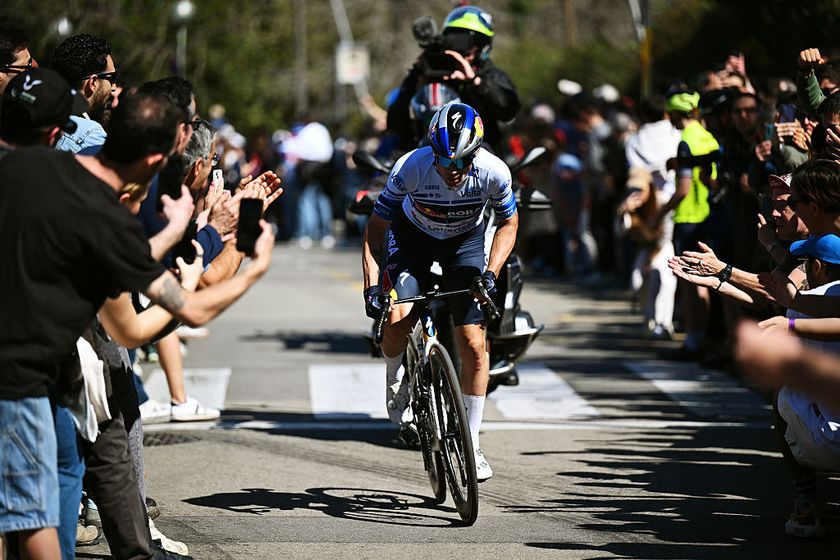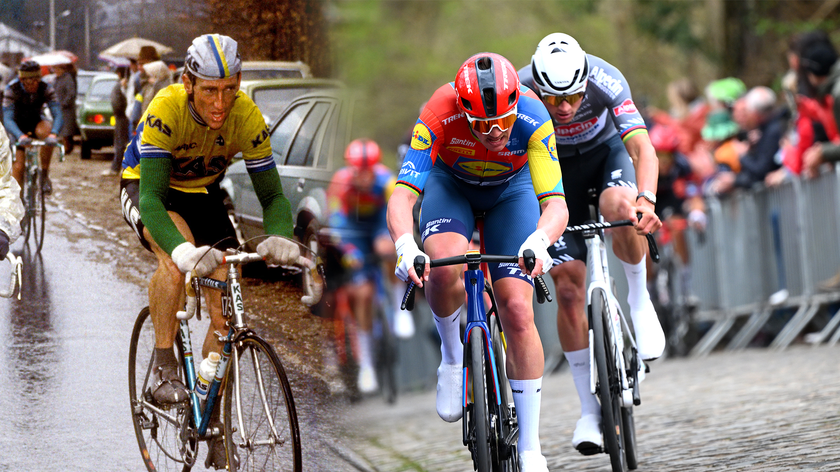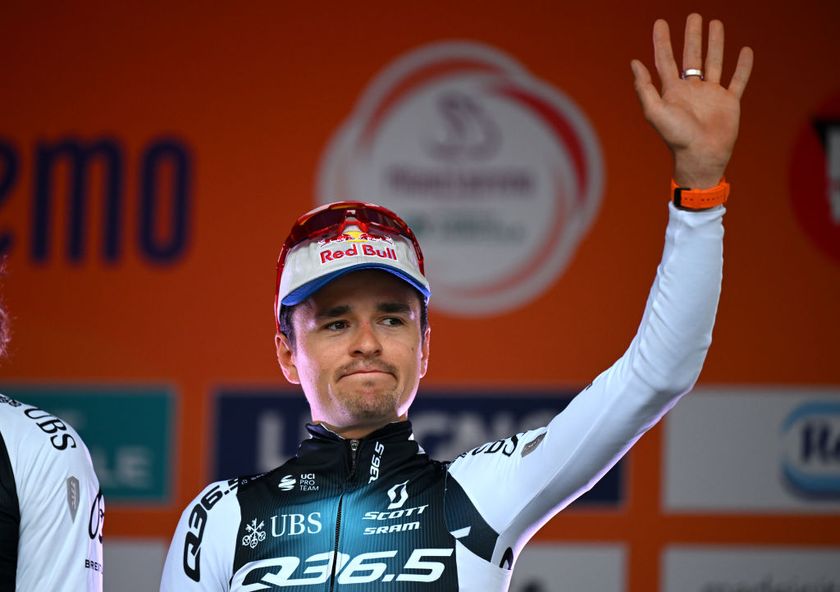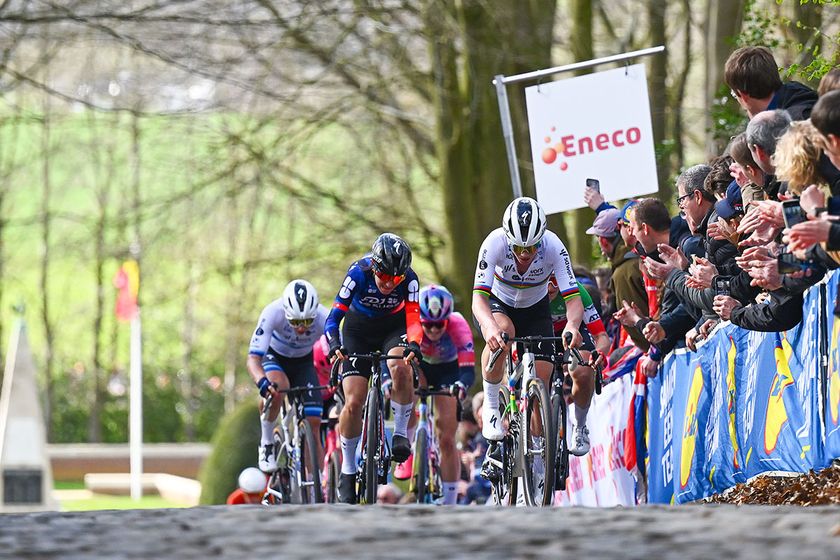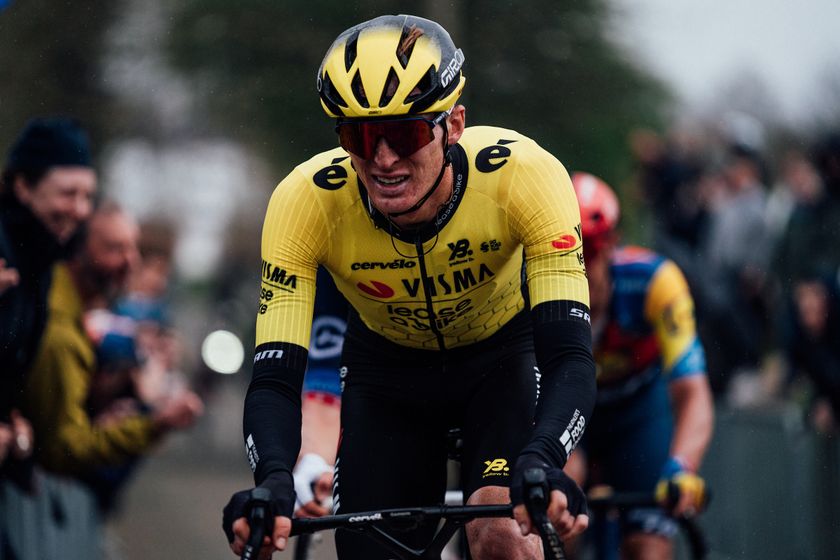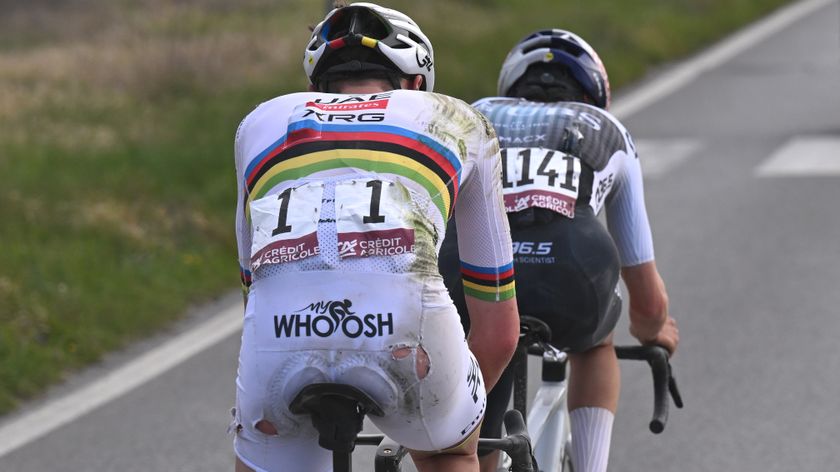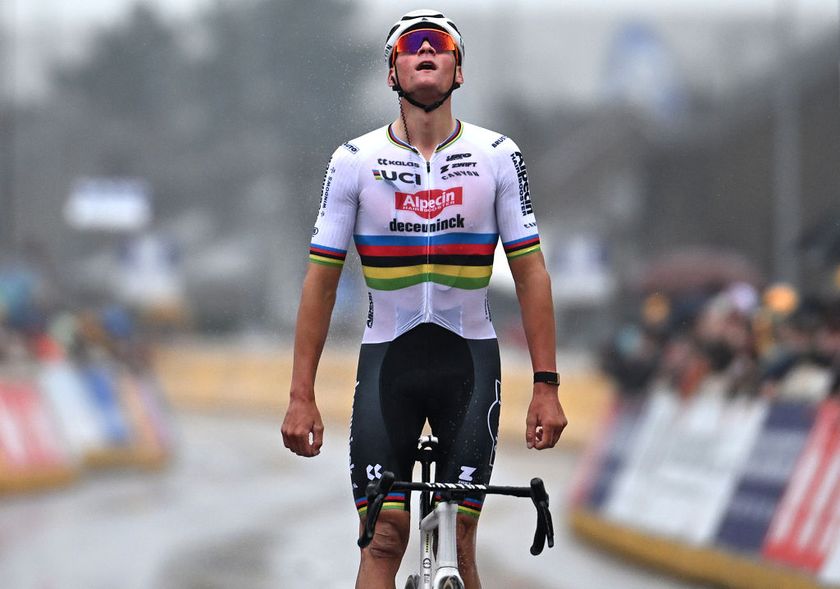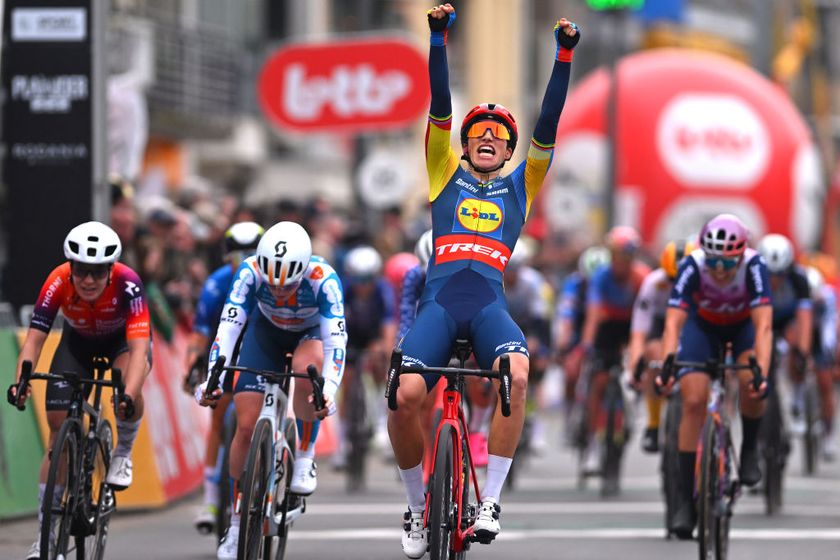Fitness questions and answers for May 2, 2005
Got a question about fitness, training, recovery from injury or a related subject? Drop us a line at...
Form & Fitness Q & A
Got a question about fitness, training, recovery from injury or a related subject? Drop us a line at fitness@cyclingnews.com. Please include as much information about yourself as possible, including your age, sex, and type of racing or riding. Due to the volume of questions we receive, we regret that we are unable to answer them all.
Carrie Cheadle, MA (www.carriecheadle.com) is a Sports Psychology consultant who has dedicated her career to helping athletes of all ages and abilities perform to their potential. Carrie specialises in working with cyclists, in disciplines ranging from track racing to mountain biking. She holds a bachelors degree in Psychology from Sonoma State University as well as a masters degree in Sport Psychology from John F. Kennedy University.
Dave Palese (www.davepalese.com) is a USA Cycling licensed coach and masters' class road racer with 16 years' race experience. He coaches racers and riders of all abilities from his home in southern Maine, USA, where he lives with his wife Sheryl, daughter Molly, and two cats, Miranda and Mu-Mu.
Kelby Bethards, MD received a Bachelor of Science in Electrical Engineering from Iowa State University (1994) before obtaining an M.D. from the University of Iowa College of Medicine in 2000. Has been a racing cyclist 'on and off' for 20 years, and when time allows, he races Cat 3 and 35+. He is a team physician for two local Ft Collins, CO, teams, and currently works Family Practice in multiple settings: rural, urgent care, inpatient and the like.
Fiona Lockhart (www.trainright.com) is a USA Cycling Expert Coach, and holds certifications from USA Weightlifting (Sports Performance Coach), the National Strength and Conditioning Association (Certified Strength and Conditioning Coach), and the National Academy for Sports Nutrition (Primary Sports Nutritionist). She is the Sports Science Editor for Carmichael Training Systems, and has been working in the strength and conditioning and endurance sports fields for over 10 years; she's also a competitive mountain biker.
Eddie Monnier (www.velo-fit.com) is a USA Cycling certified Elite Coach and a Category II racer. He holds undergraduate degrees in anthropology (with departmental honors) and philosophy from Emory University and an MBA from The Wharton School of Business.
Eddie is a proponent of training with power. He coaches cyclists (track, road and mountain bike) of all abilities and with wide ranging goals (with and without power meters). He uses internet tools to coach riders from any geography.
Get The Leadout Newsletter
The latest race content, interviews, features, reviews and expert buying guides, direct to your inbox!
David Fleckenstein, MPT (www.physiopt.com) is a physical therapist practicing in Boise, ID. His clients have included World and U.S. champions, Olympic athletes and numerous professional athletes. He received his B.S. in Biology/Genetics from Penn State and his Master's degree in Physical Therapy from Emory University. He specializes in manual medicine treatment and specific retraining of spine and joint stabilization musculature. He is a former Cat I road racer and Expert mountain biker.
Since 1986 Steve Hogg (www.cyclefitcentre.com) has owned and operated Pedal Pushers, a cycle shop specialising in rider positioning and custom bicycles. In that time he has positioned riders from all cycling disciplines and of all levels of ability with every concievable cycling problem.They include World and National champions at one end of the performance spectrum to amputees and people with disabilities at the other end.
Current riders that Steve has positioned include Davitamon-Lotto's Nick Gates, Discovery's Hayden Roulston, National Road Series champion, Jessica Ridder and National and State Time Trial champion, Peter Milostic.
Pamela Hinton has a bachelor's degree in Molecular Biology and a doctoral degree in Nutritional Sciences, both from the University of Wisconsin-Madison. She did postdoctoral training at Cornell University and is now an assistant professor of Nutritional Sciences at the University of Missouri-Columbia where she studies the effects of iron deficiency on adaptations to endurance training and the consequences of exercise-associated changes in menstrual function on bone health.
Pam was an All-American in track while at the UW. She started cycling competitively in 2003 and is the defending Missouri State Road Champion. Pam writes a nutrition column for Giana Roberge's Team Speed Queen Newsletter.
Dario Fredrick (www.wholeathlete.com) is an exercise physiologist and head coach for Whole Athlete™. He is a former category 1 & semi-pro MTB racer. Dario holds a masters degree in exercise science and a bachelors in sport psychology.
Scott Saifer (www.wenzelcoaching.com) has a Masters Degree in exercise physiology and sports psychology and has personally coached over 300 athletes of all levels in his 10 years of coaching with Wenzel Coaching.
Kendra Wenzel (www.wenzelcoaching.com) is a head coach with Wenzel Coaching with 17 years of racing and coaching experience and is coauthor of the book Bike Racing 101.
Steve Owens (www.coloradopremiertraining.com) is a USA Cycling certified coach, exercise physiologist and owner of Colorado Premier Training. Steve has worked with both the United States Olympic Committee and Guatemalan Olympic Committee as an Exercise Physiologist. He holds a B.S. in Exercise & Sports Science and currently works with multiple national champions, professionals and World Cup level cyclists.
Through his highly customized online training format, Steve and his handpicked team of coaches at Colorado Premier Training work with cyclists and multisport athletes around the world.
Brett Aitken (www.cycle2max.com) is a Sydney Olympic gold medalist. Born in Adelaide, Australia in 1971, Brett got into cycling through the cult sport of cycle speedway before crossing over into road and track racing. Since winning Olympic gold in the Madison with Scott McGrory, Brett has been working on his coaching business and his www.cycle2max.com website.
Richard Stern (www.cyclecoach.com) is Head Coach of Richard Stern Training, a Level 3 Coach with the Association of British Cycling Coaches, a Sports Scientist, and a writer. He has been professionally coaching cyclists and triathletes since 1998 at all levels from professional to recreational. He is a leading expert in coaching with power output and all power meters. Richard has been a competitive cyclist for 20 years
Andy Bloomer (www.cyclecoach.com) is an Associate Coach and sport scientist with Richard Stern Training. He is a member of the Association of British Cycling Coaches (ABCC) and a member of the British Association of Sport and Exercise Sciences (BASES). In his role as Exercise Physiologist at Staffordshire University Sports Performance Centre, he has conducted physiological testing and offered training and coaching advice to athletes from all sports for the past 4 years. Andy has been a competitive cyclist for many years.
Michael Smartt (www.cyclecoach.com) is an Associate Coach with Richard Stern Training. He holds a Masters degree in exercise physiology and is USA Cycling Expert Coach. Michael has been a competitive cyclist for over 10 years and has experience coaching road and off-road cyclists, triathletes and Paralympians.
Kim Morrow (www.elitefitcoach.com) has competed as a Professional Cyclist and Triathlete, is a certified USA Cycling Elite Coach, a 4-time U.S. Masters National Road Race Champion, and a Fitness Professional.
Her coaching group, eliteFITcoach, is based out of the Southeastern United States, although they coach athletes across North America. Kim also owns MyEnduranceCoach.com, a resource for cyclists, multisport athletes & endurance coaches around the globe, specializing in helping cycling and multisport athletes find a coach.
Gastrocnemius Tendinosis
Loss of quadriceps power
Calves and the pedal stroke
Foot Pain
Broken collar bone
Cleat location
TT training and lactate threshold
Low HR Max
Uric acid excess
Donating blood
Hip fracture
Feeling rundown
Leg length discrepancy - can't dial it in
Diabetes & Cycling
Sleep disorder posting
Gastrocnemius Tendinosis
Once again, I am going through a re-injury occurrence that, in essence, has ended my competitive cycling career, although I had been winding down anyway. I am a 50-year old male and have been cycling competitively and doing what I'll call fast club rides for the last 25 years. I'm 6 foot even and 140 pounds, so I've always enjoyed climbing, until a few years ago.
Late 2002, during a club ride, I started to have what I thought was a mild cramp in my right calf, although it somehow felt different from that. I tried repositioning my foot during that ride as best I could, but nothing changed the cramp-like feeling. Stupidly, in retrospect, I did about six more two-hour rides over a few weeks time, but I could feel a dull ache and/or tightness in my right gastrocnemius almost with every pedal stroke. After even a month or two of relatively light indoor trainer sessions proved problematic, I finally stopped and sought medical attention from a sports-oriented group of physicians (who also cycle). Prescribed anti-inflammatory drugs did nothing noticeable.
Ultimately, I was diagnosed with an inflexible hallux (big toe) that contributed to tendinosis in my right upper (proximal) gastrocnemius. My understanding of tendinosis is that it is (or can be) due to an accumulation of micro-tears at the muscle/tendon junction that has damaged the collagen. It's a slow-healing area because of limited blood enervation and the protein synthesis process takes at least three months to remodel the collagen. I started a program of icing, calf and toe stretching, moderate exercise (walking, Theraband exercises), regular professional massage therapy and, once cycling, after a 3-month layoff, a gradual build-up of intensity (a combination of distance and effort) in an attempt to remodel the injured area to accommodate cycling again to what I had once known. I also got custom orthotics to address the hallux inflexibility, actually in both feet.
At the same time, the podiatrist said the 5 mm shim on my cycling shoes and 8 mm heel lift for my perceived shorter left leg should be discarded, pointing out I had a functional leg length discrepancy instead of an actual one, contrary to what I had been told 20 years before. I don't know if this is relevant to my current problem/injury, but...The old style Time pedals and shoes were good for accommodating the shim. I now have custom Rocket 7 shoes for my one-size-different feet and use them with Look Keo pedals, with the orthotics and no shim. My cleats are fairly far back on the shoes, I should add.
My flexibility throughout my (especially lower) body can best be described as "bad," even though I have stretched regularly hamstrings, back, etc. for at least the last 10-15 years. My hamstrings, especially, are tight, even after exercise and stretching. My bike size and cockpit reach reflect that characteristic and my on-the-bike aerodynamics are limited somewhat.
Over the last two years, the tendinosis has flared back up from time to time, due to mild intervals, a difficult/long ride or otherwise building up cycling conditioning too quickly. It then takes three months or more to resolve, but it never has resolved completely, I have to say in retrospect. I can get to a point where I can exert myself cardiovascularly, but I stay away from group riding where the speeds, efforts and terrain can vary too much. In short, it has been a competitive cycling career killer. Intervals, sprinting, strong winds and most any kind of hills have been avoided, and I've paid the re-injury when I haven't.
Given all that, here are my questions.
1. Any obvious things I am doing wrong or should be doing (or considering) to prevent re-injury?
2. Are there other specific stretching or exercises you could recommend for coming back from this kind of injury?
3. Are there any foods or supplements I should consider ingesting that would aid collagen formation (by obtaining some necessary protein, say) or promote healing?
4. I've never had any problems whatsoever with Achilles' or patellar tendinosis. This injury site, which is about one or two inches below the back of the crease of the knee as best as I can palpate, seems very uncommon from what I can tell. Do you have any insights about frequency in cyclists? Really, cycling has been my only sport for the last 25 years.
Any insights, discussion or even just commiseration would be appreciated.
Mark Flotow
Springfield, IL, USA
Your story doesn't sound like a lot of fun. I think the clue to understanding your situation is that it only occurs on one side and that you have pelvic asymmetries of function, hence the functionally short leg. In your shoes, I would be seeing whoever I have to see and doing whatever I have to do to improve the general structural function of my body as a whole. If you made Pilates, yoga or whatever, your sport of choice, it would not surprise me at all if you end up back on the bike injury free, though the time this would take, I can only guess at.
Loss of quadriceps power
This is actually a follow up question from eight months ago when I inquired about possible causes for overuse of the VMO (July 2004). After experimenting with setup and following some of Steve's advice the problems appeared to mostly clear up (though without being able to produce a definitive answer).
One of the possible causes that Steve mentioned was a hip imbalance. The reason that I bring this up now is that another cycling issue might well be related. After racing or training 'very' hard for about an hour, my right quad starts to go numb and lose power. I mentioned this to a training partner who suggested that I might actually have a hip imbalance. The core muscles fatigue on one side of the body quicker than the other, leading to the quad having to compensate. He suggested visiting a physio for manipulation/follow up. (His advice coming from personal experience) The problem is that my non-cyclist physio couldn't find any problems. He suggested that I work on core strength and flexibility.
The reason that I asking this follow up question is that I've noticed that my right VMO is also still the first major muscle to fatigue. I only made the possible linkage between the two recently (not being the sharpest tool!).
So my basic question follows: are the loss of power in the right quad, and the fatiguing of the right VMO possibly related? (possiblly, as suggested, because of a hip imbalance).
And if so, what should I go back to the physio with, or alternatively, alter with bike set up? Hope you can help!
Brendan Harris
Brisbane, Australia
The VMO is the major lateral muscular stabiliser of the knee. If it is fatiguing more quickly, it is likely that there is a challenge to stability on that side and the VMO is working hard in an attempt to stabilise. As to the connection between that and the rest of the right quad going numb, I can only guess at. You mention that your physio could find nothing wrong. Did they look at the site of the problem or did they do a whole of body structural assessment. If they did not do that, find a knowledgeable one who can and will. Even better if they are a cyclist.
Calves and the pedal stroke
I got to arguing with a mate about which muscles get used when during the pedal stroke, and was hoping you could share the true "science" of it (there's a whole $10 riding on this)
The main question was about when the calves get worked. Road warriors have these amazingly defined gastrocs, but its hard to pick a loaded calf raise in the stroke. Is it in the pull up with the back leg (I think that's hamstring)? Is it just high reps that gives the definition, or is there some other point in the stroke that works them - downstroke with pointed foot?
Since I've got you started on the topic, I'd love it if you could outline the kinesiology of the whole pedal stroke
Thanks!
Nick
Melbourne, Australia
Gastoc is active during the down-stroke and first half of the upstroke (30-270 degrees). If calf muscles were not active, the heel would drop until the limit of movement of the joint was reached on every stroke. Since you asked about the whole pedal stroke, I'm attaching an abstract of an article that examined it. Sorry for the typos.
Foot Pain
My wife is a recreational cyclist who is experiencing a sudden onset of one sided foot pain located midline and behind the ball. She describes the pain as being primarily on two pressure points. She first noticed this pain after switching to a new shoe/pedal combination 3 weeks ago (Sidi Genius 5/ SPD-SL). The cleat was positioned behind the ball using the formula Steve Hogg mentioned in a previous post. Her old shoe/pedal setup was an inexpensive mountain shoe with SPD pedals. Is this normal shoe break-in pain or is there something we can do?
Jon Cover
Modesto, CA
Jon,
Broken collar bone
I recently broke my left clavicle in a biking accident. About how long does it take before I could be back out on the open road? How long does it take to completely heal? And why is it a bone that just heals without being set or pinned?
Patrick McGlynn
SF
Patrick,
Cleat location
You may recall I emailed you last month regarding calve issues.
I'm making some progress, but I have one quick question. Are there any pain symptoms of a cleat that is position too far back? (otherwise stated as the ball of the foot too far forward over the pedal axis) Or is this a case where there is no pain that develops but instead a breakdown of the pedaling dynamics/efficiency. I want to know what the signs are of going too far in that direction. Thanks.
Jim Breen
I do remember your query to CN. If the cleat is too far back, ankle movement becomes too limited and there is a loss of smoothness at the bottom of the stroke. A lack of what I call ' flow' as I don't know what else to call it. The pedal stroke becomes jerky and it is hard to pedal at high rpm. While I have seen the occasional injury caused by too rearward a cleat position, it is not common and is usually associated with too high a seat height for that cleat position. If you stick to the recommendations I gave you for cleat position plus or minus a mm or so, you will be safe and are unlikely to have problems resulting from cleat position. Don't forget to stretch those calves though!
TT training and lactate threshold
Today TT training was discussed and recommended intervals were given. The question: if one continues to train threshold levels will your lactate threshold continue to increase or will you just reach your genetic ceiling and plateau? Typically this is the time to start a different block working on a different system. Have I got all this wrong? Thanks.
Mike V
Mike,
Low HR Max
My resting heart rate is typically 45 bpm. I am a 32-year-old road cyclist. I am 5'11" and weigh 160 lbs. I average 80-100 miles per week at fairly high exertion levels. I have been using a heart rate monitor consistently for about eight months now. I've noticed that my maximum heart rate at full effort seems to be approximately 175 bpm. Try as I might, I cannot get my heart rate up to 180bpm. Am I correct in thinking that this is a somewhat low maximum rate for someone my age? If so, what condition(s) could be contributing to the low rate? Could incorrect training be a factor?
Bryan Chalk
Bryan,
Uric acid excess
I'm 32 years old, riding purely recreationally, and until a recent snowboarding injury I was putting in an average of 350 km per week over 5 rides. I've pretty much recovered from the snowboarding injury , which was to both knees and appears to have been correctly diagnosed as medial ligament strain. Just as I was beginning to start training again I started experiencing pain in my knees which felt totally different to my previous injury.
I stopped training and while I was off the bike and carrying on with only my upper body weight programme my knees progressively got worse as did my left ankle. I'd wake up in the mornings with my knees and ankle aching having gone to bed with little or no pain. This would continue throughout the day with no discernable pattern linked to anything I had done as far as I could tell.
I was talking with my physio / sports masseur about this and he asked had I been drinking coffee, which I had; well over my normal amount, and I'd also been having a couple of glasses of wine in the evenings while unable to train. Anyway, he suggested stopping the coffee and the wine and taking cider vinegar three times daily to flush my system of excess uric acid which might be causing joint inflammation. I've done as he asked and in 4 days there has been a noticeable improvement in my pain. My question is have any of the panel come across this and if so what are your thoughts and advice. Thanks.
Mark Cooney
Hi Mark,
Donating blood
With all the talk about blood transfusions (homologous and otherwise) I assume that there must be a real performance advantage to the practice, at least for world-class athletes. My question is about the opposite case - donating blood. I regularly donate to the local blood band, and they always warn me not to exercise strenuously for 24 hours. I always assumed this had to do with fluid levels.
Well, I gave my usual pint on Tuesday this week, and Sunday I tried my favorite climb. My time was 2 1/2 minutes (10%) slower than the last time I timed myself on the same course. Conditions were pretty much the same, and my perceived effort was the same. Could losing a pint 5 days earlier affect performance this dramatically? By the way, your answer won't change my donating habits, but it might give me another good excuse for being so slow.
Carl Hagenmaier
Los Altos, California
Carl,
Scott Saifer Replies
Hi Carl,
Hip fracture
Hi, I am a 57 year old male in excellent shape, at least until about two weeks ago. I am an endurance and serious recreational rider. I am 6 feet tall and weigh 200 lbs. I have been riding for years. Two weeks ago I commuted to work which I do 95% of the time and on the way home decided to use this time for a training ride. I was just turning into my ally after about 35 miles of a great ride when I hit a small patch of sand and went down on my left hip, which I fractured.
After two pins and too much laying around I am getting better, slowly and painfully. My question is; what can I do so my left leg will not atrophy too much during this time? I am on crutches with no load bearing on the right leg, only toe balance. The other thing is that the longer I am off the bike the more afraid I am to think about doing it again. I want to ride more than anything but I fight the psychological fear of falling again. Thanks.
Sonny Haas
Sonny,
Feeling rundown
Hello, I am a 44-year-old cat 2 racer. I usually do about 200-250 miles a week and also have a full time job. In The last few weeks I have been getting run down and have a constant exhaustion problem. What supplements should I be taking to help keep me going? Thanks.
Brian west
New York
Hi Brian,
Leg length discrepancy - can't dial it in
Let me tell you what I know about my body and position, and then I'll tell you where my pain is and see if you can offer any setup advice. This also includes what I've changed in the last two months. I'm a Cat 4 racer and have done 2000 miles since January 20.
First off, my right leg is shorter than my left. I have not had an X-Ray done to measure the exact length, but one licensed therapist measured it at an inch. The doctor to whom she recommended me measured it as "at least" 3/8ths of an inch. Because of back pain he sent me for an MRI (awaiting result) to check my discs and sent me for a 3/8ths inch insole for my work shoes and everyday shoes. The physio also said my right deep hip flexor was quite tight, that my right hamstring was tighter than my left, and that my pelvis was twisted (right up, left down I believe). I used to play running sports (soccer, lacrosse) and never noticed any issues with movement. I am actually fairly flexible compared to my teammates, but I know that might not mean much.
On long rides my whole lumbar region, especially the left side, would get progressively more uncomfortable and sore and painful. I also noticed that my right knee always lined up in front of my left, and, lastly, that my pelvis was crooked on the saddle. This was noticeable by feel as well as by the Selle San Marco branding on my shorts which sat to the right side (looking from the back... I thought it would be the opposite) and more forward on the right as well. My inner thigh on the right would rub the nose of my saddle as well. My left leg seemed stronger and more evenly developed in the quads and the hamstrings. I also began to notice that my right IT band was quite tender after long rides. The physio saw me after I noticed all this body stuff, actually.
Once I saw the doc, who prescribed the lift, I went to the LBS and got two of the sidi plates (two year old genius model) and added those to the sole of the shoe between the cleat and the sole (on top of another plate, actually). I use the Shimano Ultegra "Lance" pedals. I have the cleat as far back as it will go, which barely gets the ball of my foot ahead of the spindle. Anyway, I put these on, and I immediately noticed a feeling of more strength and balance on the bike. I would say the two plates measured 3/8ths of an inch total. I have a powertap, and I noticed an increase in power, which could have been due to training. My IT band felt better after rides, and I raised my saddle a few mms, until I felt comfortable, basically. I rode a good number of miles over the course of three weeks with the new plates, and I would say I felt less crooked and more powerful. I had to adjust my right cleat as well, pointing my toes slightly more outward than before. Knees good, ankles good, IT band better, etc.
I began to sense that my body had loosened up a little. I had also been using the lift for a month and had been stretching my quads, hammies, and especially my right hip flexor (psoas?) after every ride. Oddly enough, I began to feel a bit crooked on the bike again. No new pain, just not quite straight. Maybe I became more sensitive to less of a difference. So I added another plate. This raises the difference to about half an inch. I raised the saddle again, but not too much. Knees feel good. Two weeks later, and I still feel ok, but something's not quite lined up. I still sit with my right sit bone farther forward, and yesterday during my first long RR of the season (60 mi), my left lower back became quite tight and painful again. It was cold and raining, but it was worse than I have experienced in a while, though I've been riding 60 miles and more on the weekends for months now.
Also, I've noticed that my left cleat seems to move around in the pedal fore and aft more than the right. In fact, it makes a clicking noise during pedal strokes as the cleat hits the front or back of the pedal. The right has never done this. The noise is not new. My pelvis now feels a little straighter, and I never rub my right thigh on the nose of the saddle, which is now straight; however, my right knee tracks to the outside, which is new I think. I'm just trying to figure myself out as best as possible. I suspect that some of my LLD is in the femur and some is in the tibia.
One last variable: I separated my left shoulder in high school, and my clavicle on that side sits slightly higher as the tendon was stretched permanently when injured. This makes it hard to tell if my left arm is also longer than my right, or if my shoulders are just off kilter. On the whole, I have good core strength and have a fairly balanced musculature in my upper body. I ride a bike that's a bit long for me in the top tube and run 170 mm cranks. My new ride should arrive shortly. My coach/the fitting guy (he is one and the same) at the local shop has put me on a smaller frame (a CAAD 8 52cm) with the FSA big setback post (to make up for the steep seat tube - he says I have longer femurs which affect my balance and explains my desire to scoot farther back than I can on other posts and my current ride) and 175 mm crankarms. My current setup on my 1994 Schwinn Super Sport is a little too "agressive" for the hoods and drops, I think, but needs to be that way (short stem already) in order to put my butt back enough. I'm not sure what other information I could give you, but I would really appreciate any advice you have for the LLD, the back pain, etc. as well as comments on what I've done with the three plates as shims and the new setup on the bike.
I hope reading the long question and info hasn't knackered you too much. I'm tired just from writing it! Again, your comments and advice would be much appreciated. I do try to take a dynamic approach to my position, as you advise, and I think it's been very helpful.
Zach Hoover
Yeah, you have posed a long question; but I wish there were more people with your body awareness and sensible approach to solving their own problems. Because you have posed a lengthy one it is easier to break this response down to point form.
Diabetes & Cycling
In regards to the questions submitted by Lance Sanderson, I can provide some personal experiences. I have been a Type 1 diabetic for 5.5 years, using multiple kinds of insulin (including Novolin N, Novolog, and Lantus), and now a Medtronic insulin pump. I understand the fear of blacking out due to hypoglycemia, I still can sense when this is happening, but I know many diabetics who cannot. I also ride 100-200 miles per week, and have never passed out while cycling, or during any other form of workout. If you want precise control over blood glucose levels and insulin delivery, I highly recommend an insulin pump. Dosing is more convenient and precise than with needles, and the control that you have is enormous. The insulin pump uses short-acting insulin (Novolog, in my case), that is delivered at what is called a basal rate.
You can have multiple basal rates for different times of the day, as well as the ability to set temporary basal rates for up to 4 hours. When you eat, you enter your blood glucose level and amount of carbohydrate being eaten, and the pump provides you with a bolus of insulin (measured to the tenth of a unit) to cover that meal.
The feature that I have found critical for maintaining my cycling is the temporary basal rate. A few minutes before I leave to ride, I set the basal rate to 50% for the length of my ride. If my basal rate was 1.1 u/hr, then the pump will only deliver .55 u/hr while I am riding. This prevents the sudden hypoglycemia that can occur when you combine exercise and insulin. I always ride with extra food, especially gels, as they are an easy way to recover from an episode of hypoglycemia. The key disadvantage of Lantus in this situation is that it provides the same level of activity for 24 hours, whether or not you need it. While exercising, you just don't need as much insulin. Another product that may help is using a heart rate monitor with calorimeter, like a Polar. The calorimeter isn't very accurate, but as long as it is consistent, it will help you figure out how much you need to eat to maintain normal blood glucose levels while riding.
Finally, learn just how much insulin or carbohydrate your body needs for each ride based upon time (not mileage), effort, and weather conditions. You can avoid hypoglycemia by eating just the right amount as you go along, while still getting the benefits of exercising. Keep the rubber side down, and don't hesitate to send me an email if you have more questions.
Ari Weinstein
Sleep disorder posting
Hi guys, I just read this posting
The response by Kelby didn't state this, but to me it looks like the guy may have insomnia caused by overtraining.. It is a well-known symptom. A few years ago I was living in France and did 5 months of training in advance of the season. While the workload on any specific week didn't seem huge, the fact that I was training alone and that each of my spins was probably run off at a pace 10 bpm too high for endurance training meant that I got quite run down. One of the symptoms of this was waking up at 4 am each morning and being totally incapable of getting back to sleep. Sounds like Paul is having this problem. His carb intake may be helping him to deal with the overtraining and thus helping him a little but I'd hazard a guess that it is the miles/efforts he is doing which could well be causing the problem. All the best.
Shane Stokes
